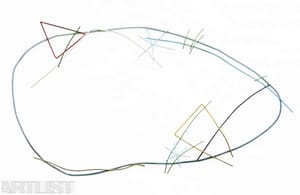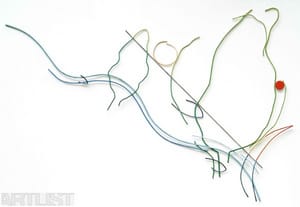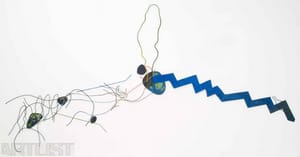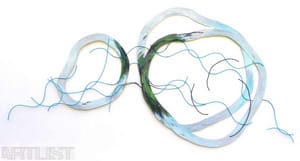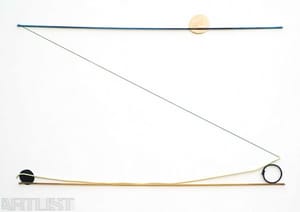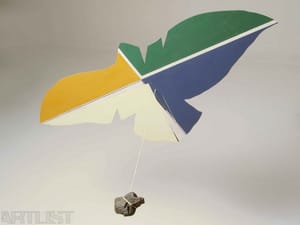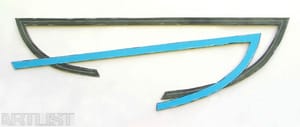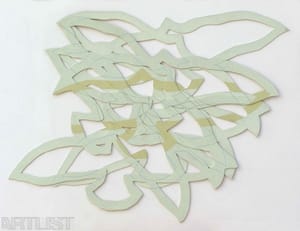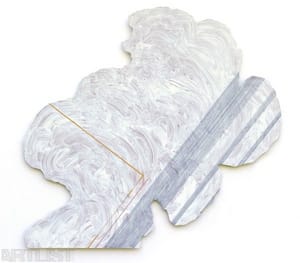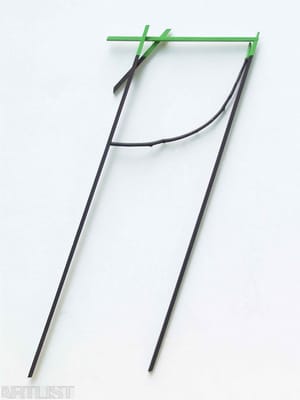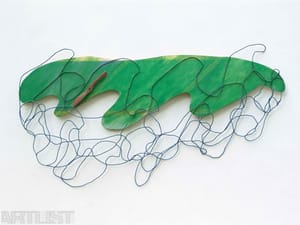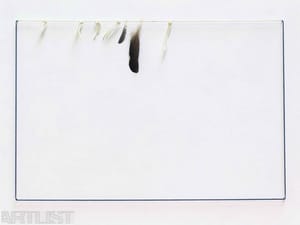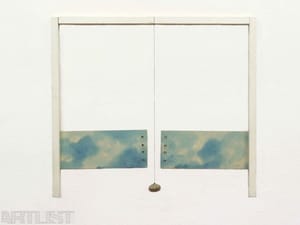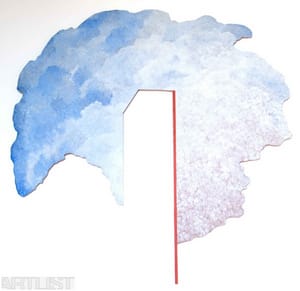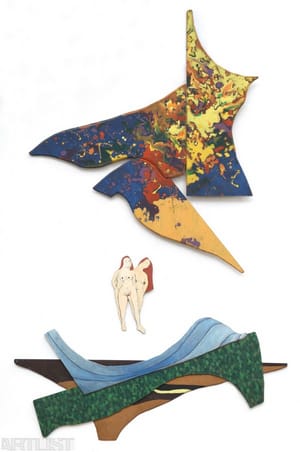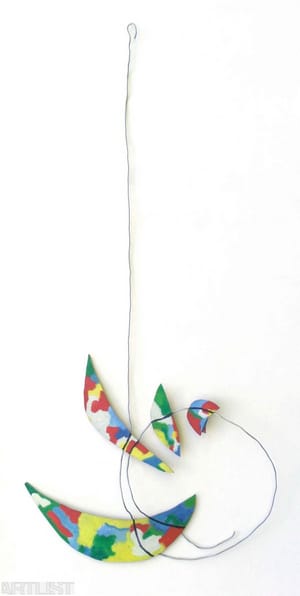- First Name
- Jiří
- Surname
- Kubový
- Born
- 1950
- Birth place
- Most
- Place of work
- Ústí nad Labem
- Website
- www.jirikubovy.cz
- CSU Library
- ↳ Find in the catalogue
About artist
The work of Jiří Kubový, beginning at the end of the sixties, defies art-history or theoretical pigeon-holding. We can find minimalistic and conceptual elements and procedures, which correspond to the progressive artistic tendencies of that time, and yet the artist himself denies such elements. Geometrising morphologies are challenged by a thorough, detailed oil painting or by the inclusion of a concrete item (a spring, key, stone, etc.), which underscores the poetic impression of the work. We can perceive Kubový’s pictures as a distinctive and systematic dialogue held not only with fine art (above all with the form of classic, hung painting), but also with literature (poetry) and the world around us (nature, the landscape and its elements, atmospheric phenomena, the universe). It is these elements which are the key motifs defining Kubový’s work in terms of both content and form.
Jiří Kubový began painting systematically in 1968, when he created his first oil paintings (Besieged Azure, 1969). However, he disturbed the classical format of a painting by breaking, cutting and moulding it. This resulted in pictures with irregular formats made of cardboard or hardboard often combined with other materials (wooden slats, wires, sand, mirrors). From the second half of the seventies the artist worked on cycles (1982-83 a cycle of rope pictures, 1980-84 the extensive cycle Nets, 1994-98 the cycle Drawings on Wood, etc.). The pivotal theme of Kubový’s works which appears constantly from the seventies onwards and in the nineties dominates his work is the landscape. The landscape takes many forms and shapes. For instance, the rope pictures, also called “empty”, can be a landscape, i.e. presented in colour in the shape of a rectangle of a tightened string (Picture, 1982), though also complex large wire compositions (Large Landscape, 2007; Landscape, 2008), which are of monumental proportions. Landscape can be represented by individual natural elements (Stones and Water, 2006), or can be poetically combined as over the last few years (Marrow and Star, 2010). At present the theme of the landscape is being transformed into pictures of the Říp mountains, following on from the cycle Old Volcanoes from the second half of the eighties.
In the seventies Jiří Kubový struck up friendship with important artists (Jiří Kolář, Ladislav Novák, Emil Juliš, Jan Kubíček, Jiří Valoch, etc.), who had a significant influence on him. He collaborated on specific works with some of them. On the other hand the person of Jiří Kubový, his compact artwork and unusual view of art, supported by his own activities as collector, contacts with important authors – all of this had a great influence on the formation of the personalities of the “Ústí Circle” (e.g. Michal Koleček, Martin Kolář, Jan Řezáč and others ). Jiří Kubový was also present at the creation of the charity organisation People for Fine Art – Fine Art for People, which since the nineties has been run by the Emil Filla Gallery in Ústí nad Labem.
- Author of the annotation
- Vendula Fremlová
- Published
- 2011
CV
Autodidact
Stipends:
1988 stipend of the Ford Foundation in Paris
Employment:
2004 left his job and began working as an artist
since 1968 worked as an economist and banker
Exhibitions
- Solo exhibitions
-
2011
Jiří Kubový: In der luft, Rathaus, Pirna
Jiří Kubový: Ve vzduchu, Galerie moderního umění v Roudnici nad Labem, Roudnice nad Labem
2010
Ústí nad Labem, „Věčná krajina“, Galerie Emila Filly (24. 11. 10- 14. 1. 11)
Praha, Galerie Dion (8. 3.-24. 4.)
2009
Úštěk, „Krajiny v trávě“, Synagoga a gotické dvojče (30. 4.-14. 6.)
Praha, „Krajiny“, Galerie Litera (19. 1.-27. 2.)
2008
Brno, „Mezi nebem a zemí“, Galerie Brno (6. 5.-22. 6.)
2007
Brno, „Prázdné obrazy, krajiny a stromy“, Galerie Na bidýlku (29. 11. 07-10. 1. 08)
Litvínov, „Krajiny“, Galerie Modrý hrozen (21. 9.-16. 11.)
2005
Olomouc, „Dříve a nyní“, Galerie Caesar (6. 9.-30. 9.)
Hradec Králové, „Voda a tráva“, Galerie AMB (3. 10.- 4. 11.)
Česká Lípa, „O krajině“, Jídelna-galerie Vlastivědného muzea v České Lípě (12. 5.-5. 6.)
Selb, „Vögel, Wolken und Wasser“, Galerie Goller (1. 5.-13. 7.)
2004
Mělník, „Roční období“, Galerie Erasmus (5. 8.-1. 9.)
Plzeň, „Kapky oceánu“ (společně s M. Maurem a M. Zetem), Galerie města Plzně (8. 1.-15. 2.)
2003
Litoměřice, „Obrazy a kresby 1975-2003“, Severočeská galerie výtvarných umění (15. 5.-22. 6.)
2002
Brno, Galerie Na bidýlku (22. 3.-30. 4.)
2001
Ústí nad Labem, Výstavní síň E. Filly (7. 3.-5. 4.)
2000
Louny, Lounská výstavní síň Telecom (15. 5.-23. 6.)
1998
Brno, Galerie u dobrého pastýře (6. 2.-8. 3.)
1996
Louny, Nemocnice s poliklinikou
1994
Praha, Artotéka (6. 6.-1. 7.)
1993
Liberec, Malá výstavní síň SKS (26. 10.-13. 11.)
Ústí nad Labem, Výstavní síň E. Filly (4. 5.-27. 5.)
1992
Třebíč, Malovaný dům (9. 6.-5. 7.)
Brno, Galerie J. Krále (26. 2.-5. 4.)
1991
Ostrava, Galerie Della (4. 3.-1. 4.)
1990
Praha, Galerie Opatov (17. 12. 90 - 4. 1. 91)
Ústí nad Labem, Činoherní studio (4. 6.-30. 6.)
Opava, Studio MDK PB (10. 4.-11. 5.)
1989
Brno, Atelier-galerie arch. J. Chloupka (12. 12. 89 -12. 1. 90)
1988
Praha, Makromolekulární ústav ČSAV (25. 7.-11. 8.)
- Group exhibitions not included in ARTLIST.
-
Since 1982 Kubový participated in more than 45 group exhibitions in the Czech Republic and abroad
2013
Doteky hudby, Severočeská galerie výtvarného umění v Litoměřicích, Litoměřice
2011
Současná česká krajina: Krajinomalba a jiné cesty ke krajině, Galerie moderního umění v Hradci Králové, Hradec Králové
Duše krajiny, duch místa, Galerie U Betlémské kaple, Praha
2008
Velké prádlo, Galerie Caesar, Olomouc
Kalendáře pro Jindru Štreita, Galerie Smečky, Praha
Ladislav Daněk: 2x50 / Projekt-neprojekt, Galerie Caesar, Olomouc
2007
Hory, skály, kameny, Oblastní galerie Vysočiny v Jihlavě, Jihlava
Hory, skály, kameny, Výstavní síň Husova 19-21, Praha
2006
Od země přes kopec do nebe...: O chůzi, poutnictví a posvátné krajině, Zámek Klenová, Klenová
Kalendáře pro Jindru Štreita, Dům umění, přednáškový sál, Ostrava
2005
Od země přes kopec do nebe...: O chůzi, poutnictví a posvátné krajině, Severočeská galerie výtvarného umění v Litoměřicích, Litoměřice
Aqua naturata - Aqua naturans, Východoslovenská galéria, Košice
2003
Kapky oceánu, Galerie města Plzně, Plzeň
Minisalon, Centre tchèque Paris (České centrum Paříž), Paříž (Paris)
2002
Objekt - objekt: Metamorfózy v čase / Object - object: Metamorphoses in time, Pražákův palác, Brno
2001-2002
Středohoří, Výstavní síň U kostela, Bílina
Jiří Kolář sběratel / Jiří Kolář the Collector, Veletržní palác, Praha
2001
Horizonty, Galerie U prstenu, Praha
Objekt - objekt: Metamorfózy v čase / Object - object: Metamorphoses in time, Dům U Černé Matky Boží, Praha
2000
Devadesátka pokračuje, Objekt ČNB, Ústí nad Labem
Devadesátka pokračuje, Muzeum města Ústí nad Labem, Ústí nad Labem
1999
Ostrava - Ústí, Výstavní síň Sokolská 26, Ostrava
Súčasné české umenie (zo súkromej zbierky), Galéria Z, Bratislava
1998
Nestandartní formáty, Galerie Caesar, Olomouc
Nestandartní formáty, Galerie města Blanska, Blansko
1997
Mezi tradicí a experimentem. Práce na papíře a s papírem v českém výtvarném umění 1939-1989, Trojlodí, Olomouc
1995
Umění frotáže, Oblastní galerie v Liberci, Liberec
1993
Minisalon, Musée des Beaux Arts, Mons
1990
90 autorů v roce ´90, Palác kultury, Praha
1987
Dablovky, Galerie H , Kostelec nad Černými lesy
1982
Od kresby k prostoru, Muzeum dělnického hnutí, Semily
- Collections
-
Public Collections:
The University of Michigan Museum of Art, Ann Arbor
Galerie Brno, Brno
Vlastivědné muzeum a galerie, Česká Lípa
Severočeská galerie výtvarného umění, Litoměřice
Kunsthalle Nürnberg, Nürnberg
Dům umění, Olomouc
Národní galerie, Praha
Muzeum Kampa, Praha
Galerie moderního umění, Roudnice nad Labem
Monography
- Monography
Tomáš Vlček, „Náznak portrétu Jiřího Kubového jako těžko zařaditelného umělce“, text v katalogu k výstavě Jiří Kubový: Věčná krajina v Galerii Emila Filly v Ústí nad Labem. LVU-VUL, o.p.s. a FUD UJEP Ústí nad Labem, 2010
Vendula Fremlová, „Věčná krajina“, text v katalogu k výstavě Jiří Kubový: Věčná krajina v Galerii Emila Filly v Ústí nad Labem. LVU-VUL, o.p.s. a FUD UJEP Ústí nad Labem, 2010
Martin Kolář, „Jiří Kubový - Hledání tvaru“, text v katalogu k výstavě Jiří Kubový: Věčná krajina v Galerii Emila Filly v Ústí nad Labem. LVU-VUL, o.p.s. a FUD UJEP Ústí nad Labem, 2010
Ivo Janoušek, text v katalogu k výstavě v Galerii Dion. Praha, 2010
Petr Štěpán, text v katalogu k výstavě v Galerii Litera. Praha, 2009
Ilona Víchová-Czakó, „Mezi nebem a zemí“, text v katalogu k výstavě v Galerii Brno. Brno, 2008
Jiří Machalický, text v katalogu k výstavě v Galerii Brno. Brno, 2008
Jiří Valoch, text v katalogu k výstavě v Galerii Caesar. Olomouc, 2005
Jiří Valoch, text v katalogu k výstavě v Severočeské galerii výtvarných umění. Litoměřice, 2003
Zbyněk Sedláček, text v katalogu k výstavě v Lounské výstavní síni Telecom. Louny, 2000
Michal Koleček, text v katalogu k výstavě v Galerii E. Filly.Ústí nad Labem, 1993
Jiří Valoch, text v katalogu k výstavě v Galerii J. Krále. Brno, 1992
Jindřich Chalupecký, text v katalogu k výstavě v Salonu Mina. Litvínov, 1988
- Articles
Martin Nitsche, „Věčná krajina“. Ateliér 25-26 / 2010
Hana Babyrádová, „Mezi věcností a věčností“, Art and Antiques, červen 2008
Martin Kolář, „Mezi nebem a zemí“, Ateliér 12 / 2008
Martin Kolář, Původní krajiny Jiřího Kubového. Pandora 13 / prosinec 2006
Igor Zhoř, Výzvy představivosti. „Literární noviny“, 2.4.1992

